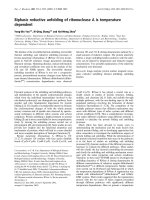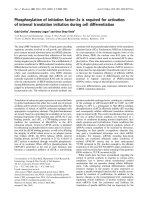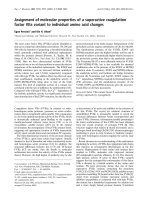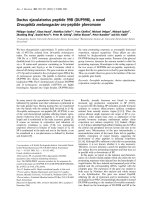Báo cáo y học: "Simplified Acute Physiology Score III: a project for a new multidimensional tool for evaluating intensive care unit performance" ppsx
Bạn đang xem bản rút gọn của tài liệu. Xem và tải ngay bản đầy đủ của tài liệu tại đây (33.26 KB, 2 trang )
345
EURICUS = European Research in Intensive Care Units; ICU = intensive care unit; SAPS = Simplified Acute Physiology Score.
Available online />Over the past 25 years, intensive care units (ICUs) have
created a body of pathophysiologic knowledge that has
enabled advances to be made in the treatment of patients.
At the same time, a series of tools have been designed to
evaluate, from multiple perspectives, the care outcomes
obtained. Research has also been conducted in parallel on
improvements in ICU management, especially the European
Research in Intensive Care Units (EURICUS) Project [1].
In short, a set of central parameters or dimensions has been
developed that determine the outcomes obtained. Standing
out among these central dimensions are the patient case mix,
the technical competence of the medical and nursing teams,
the resources available, and the culture and organisational
model. Outcomes can in turn be summarised under five
different subheadings: mortality, quality of life of survivors,
consumption of resources generated and associated costs,
level of satisfaction of patients, relatives and health care
professionals, and continuous quality improvement.
The Simplified Acute Physiology Score (SAPS) III Outcomes
Research Group [2,3] is developing an ambitious
observational study aimed at creating a multidimensional
instrument for the global evaluation of ICU performance.
Among its specific objectives are the update of SAPS in the
light of the experience of recent years and the creation or
application of novel instruments in the areas of infections and
costs. A further aim is the achievement of international
validation [4]
Aspects investigated
With respect to mortality, a third version of SAPS [3] is being
prepared that will strengthen some features of the score. It
will thus incorporate the reasons for admission, a larger
number of comorbidities and patient location prior to ICU
admission. The most novel feature, however, is that the SAPS
will take account of the variability in clinical practice, so that it
will gather the withdrawal or not of active therapeutic
measures and the transfer to other hospitals [5]. Because
Commentary
Simplified Acute Physiology Score III: a project for a new
multidimensional tool for evaluating intensive care unit
performance
Guillermo Vazquez
1
, Salvador Benito
2
and Ricardo Rivera
3
, from the Spanish Project for the
Epidemiological Analysis of Critical Care Patients
1
Departamento de Medicina y Urgencias, Hospital de la Santa Cruz y San Pablo, Barcelona, Spain
2
Hospital de la Santa Cruz y San Pablo, Barcelona, Spain
3
Hospital Virgen de las Nieves, Granada, Spain
Correspondence: G Vazquez,
Published online: 3 March 2003 Critical Care 2003, 7:345-346 (DOI 10.1186/cc2163)
This article is online at />© 2003 BioMed Central Ltd (Print ISSN 1364-8535; Online ISSN 1466-609X)
Abstract
The Simplified Acute Physiology Score III Outcomes Research Group is developing an international
multidimensional instrument for the global evaluation of intensive care unit performance. Among its
specific objectives are the update of a severity of illness index (Simplified Acute Physiology Score) with
a mortality prediction equation, with the hindsight of recent years, and the creation or application of
novel instruments in the areas of infections and cost-effectiveness. Some important measurements
such as the quality of life and the satisfaction of patients and professionals are not included. A further
aim is the achievement of international validation.
Keywords cost-effectiveness, intensive care unit, outcomes research, quality of life, severity of illness index
346
Critical Care October 2003 Vol 7 No 5 Vazquez et al.
mortality is considered at 28, 60, and 90 days, the design
would be improved if it were taken into account that, after
ICU discharge, the mortality is affected by other influences
that become progressively more important with the passage
of time [6]. This aspect, which receives little attention in
existing severity indexes, could improve our ability to predict
immediate and late mortality.
On the basis of our experience with the APACHE III system
[7], generic tools incorrectly classify and discriminate the
mortality of patients with infections. The creation of a new
index of severity and a mortality prediction equation would
therefore seem appropriate, especially given the very high
cost of new drugs. We need an instrument that allows us to
assess their true effect on the mortality of these patients.
Regarding resource consumption and costs, a key proposal
is to obtain data on the costs per patient [8]. However,
although of great interest, it is highly possible that most ICUs
will not be able to provide this information, which may be
difficult for health care professionals to gather. This is
because the decentralised management of economic
resources has not been implemented by most ICUs and
because clinicians, even many heads of service, have
inadequate knowledge of budget management issues [1,8].
The EURICUS study reported that 51% of ICU costs are
fixed and 49% are variable. Differences in costs among ICUs
depend especially on the use of certain drugs and the
nurse/bed ratio. It is possible that, with their current level of
knowledge, physicians could make a greater contribution to
the rationalisation of costs, by managing novel and very
costly new therapies using the evidence-based medicine
approach [9]. With respect to the nurse/bed ratio, an
instrument such as the Therapeutic Intervention Scoring
System, in any of its current versions [10], is needed to
evaluate the adequate nursing workload. SAPS III does not
gather any of these data, so there may be a loss of
information that is important for the interpretation of results
obtained in other areas of the study.
Quality of life is not included among the objectives of the
SAPS III study. One of the advantages of its management as
an outcome is that treatments can be selected that offer a
substantial improvement in the quality of life of patients for the
same mortality [11]. The best known example in critical
medicine is the approval of thrombolytic treatment for
ischemic stroke, based on an improvement of the quality of life
and not of the mortality, which remains unchangeable [12].
Given the objective relationship that exists between other
dimensions that are not analysed in the study (e.g.
satisfaction [13] and culture [14], among others), it would be
desirable to include these dimensions in a tool that attempts
to offer an overall and multidimensional analysis of ICU
performance [2].
The wide variability among countries or even within countries
with regard to patient type, resources and professional profile
means that tools designed for international application
present defects that must be resolved at a local level [7].
The computer systems now in wide use by hospitals should
allow the data for many of these instruments to be collected
automatically as part of routine care. This implies a
competitive advantage that SAPS III will incorporate in its
design. Nevertheless, the maintenance and continuous
improvement of these systems and the development of the
appropriate software support requires novel solutions to be
sought, so that this scale of effort is matched by adequate
funding during the time required for the definitive
incorporation of these instruments in the ICUs [15].
Competing interests
None declared.
References
1. Reis Miranda D, Ryan DW, Schaufli WB, Fidler V: Organisation
and Management of Intensive Care. First edition. Berlin: Springer
Verlag; 1998.
2. SAPS III Project [www.saps3.org].
3. Le Gall JR, Lemeshow S, Saulnier FA: New Simplified Acute
Physiology Scores (SAPS II) based on a European/North
American Multicenter Study. JAMA 1993, 170:2957-2963.
4. Randolph A, Guyatt G, Carlet J: Understanding articles compar-
ing outcomes among intensive care units to rate quality of
care. Crit Care Med 1998, 26:773-781.
5. Zimmerman J: Measuring intensive care unit performance: a
way to move forward. Crit Care Med 2002, 30:2149-2150.
6. Rivera R, Sanchez-Cruz J, Abizanda R, Vazquez G: Quality of life
before intensive care unit admission and its influence on
resource utilisation and mortality. Crit Care Med 2001, 29:
1701-1709.
7. Rivera R, Vazquez G, Aguayo E, Zimmerman J, Wagner D, Knaus
W: The APACHE III System customised mortality predictions
for Spanish ICU patients. Intensive Care Med 1998, 24:574-
581.
8. Coughlin M, Angus D: Economic evaluation of new therapies in
critical illness. Crit Care Med 2003, 31(suppl):S7-S16.
9. Sakectt D, Richardson W, Rosenberg W, Haynes R: Evidence-
Based Medicine. First edition. New York: Churchill-Livingstone;
1997.
10. Reis Miranda D: The therapeutic intervention scoring system:
one single tool for the evaluation of workload, the work
process and management. Intensive Care Med 1997, 23:615-
617.
11. Grady K: Beyond morbidity and mortality: quality of life out-
comes in critical care patients. Crit Care Med 2001, 29:1844-
1846.
12. The National Institute of Neurological Disorders and Stroke rt-PA
Stroke Study Group: Tissue plasminogen activator for acute
ischemic stroke. N Engl J Med 1995, 333:1581-1587.
13. Daley L: The perceived immediate needs of families with rela-
tives in the intensive care setting. Heart Lung 1984, 13:231-
237.
14. Shortell S, Zimmerman J, Rousseau D, Gillies RR, Wagner DP,
Draper EA, Knaus WA, Duffy J: The performance of intensive
care units: does good management make a difference? Med
Care 1994, 32:508-525.
15. Knaus W: APACHE 1978–2001: the development of Quality
Assurance System based on prognosis milestones and per-
sonal reflections. Arch Surg 2002, 137:37-41.









